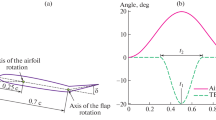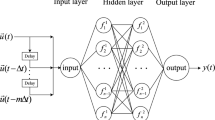Abstract
Due to the strong nonlinear properties of the entire flutter process [including growth stages, decay stages and steady limit cycle oscillations (LCOs)], the generalization of the self-excited force model for the entire flutter process of bluff bodies is a very critical issue. This paper proposes a self-excited force model based on a novel long short-term memory (LSTM) neural network to simulate the entire flutter process for various leading-edge configurations. To obtain the dataset, the nonlinear flutter with the growth stages, decay stages and steady LCOs for different leading-edge aerodynamic configurations is investigated by a series of two-degrees-of-freedom spring-suspended sectional model tests. Based on the measured flutter responses and self-excited forces in the tests, a data-driven self-excited force model is proposed on the basis of a novel LSTM neural network. Considering that the nonlinear dynamic system is very sensitive to the accuracy of the model parameters, the Newmark-\(\beta \) method is incorporated into the LSTM networks and forms a closed-loop process to restrain the error amplification effects and improve the model robustness, that is, the response calculated from the output of LSTM (the self-excited force) by the Newmark-\(\beta \) method is set as the input of LSTM at the next step rather than the measured response. To validate the performance of the proposed model, the flutter critical wind speed, time history of oscillation and self-excited forces, steady-state oscillation amplitude and flutter development process predicted by the model are compared with the test results. The comparison indicates that the predicted results agree well with the test results, meaning that the proposed model has high accuracy, generalization and robustness in describing the nonlinear characteristics of the flutter for various aerodynamic configurations.



















Similar content being viewed by others
References
Scanlan, R.H., Tomko, J.J.: Airfoil and bridge deck flutter derivatives. J. Eng. Mech. Div. 97, 1717–1737 (1971)
Scanlan, R.H., Lin, W.H.: Effects of turbulence on bridge flutter derivatives. J. Eng. Mech. Div. 104, 719 (1978)
Sarkar, P.P., Jones, N.P., Scanlan, R.H.: Identification of aeroelastic parameters of flexible bridges. J. Eng. Mech. 120(8), 1718–1742 (1994)
Scanlan, R.H.: Amplitude and turbulence effects on bridge flutter derivatives. J. Struct. Eng. 123, 232–236 (1997)
Chen, A., He, X., Xiang, H.: Identification of 18 flutter derivatives of bridge decks. J. Wind Eng. Ind. Aerodyn. 90, 2007–2022 (2002)
Argentini, T., Rocchi, D., Muggiasca, S., Zasso, A.: Cross-sectional distributions versus integrated coefficients of flutter derivatives and aerodynamic admittances identified with surface pressure measurement. J. Wind Eng. Ind. Aerodyn. 104, 152–158 (2012)
Xu, F., Zhu, L., Ge, X., Zhang, Z.: Some new insights into the identification of bridge deck flutter derivatives. Eng. Struct. 75, 418–428 (2014)
Zhu, Z., Gu, M.: Identification of flutter derivatives of bridge decks using CFD-based discrete-time aerodynamic models. Wind Struct. 18, 215–233 (2014)
Matsumoto, M.: Aerodynamic damping of prisms. J. Wind Eng. Ind. Aerodyn. 59, 159–175 (1996)
Matsumoto, M., Daito, Y., Yoshizumi, F., Ichikawa, Y., Yabutani, T.: Torsional flutter of bluff bodies. J. Wind Eng. Ind. Aerodyn. 69, 871–882 (1997)
Matsumoto, M., Shirato, H., Yagi, T., Shijo, R., Eguchi, A., Tamaki, H.: Effects of aerodynamic interferences between heaving and torsional vibration of bridge decks: the case of tacoma narrows bridge. J. Wind Eng. Ind. Aerodyn. 91, 1547–1557 (2003)
Amandolese, X., Michelin, S., Choquel, M.: Low speed flutter and limit cycle oscillations of a two-degree-of-freedom flat plate in a wind tunnel. J. Fluids Struct. 43, 244–255 (2013)
Arena, A., Lacarbonara, W., Marzocca, P.: Post-critical behavior of suspension bridges under nonlinear aerodynamic loading. J. Comput. Nonlinear Dyn. 11(1), 1–11 (2016)
Zhang, M., Xu, F., Ying, X.: Experimental investigations on the nonlinear torsional flutter of a bridge deck. J. Bridge Eng. 22(8), 04017048 (2017)
Zhou, R., Ge, Y., Yang, Y., Du, Y., Zhang, L.: Wind-induced nonlinear behaviors of twin-box girder bridges with various aerodynamic shapes. Nonlinear Dyn. 94(2), 1095–1115 (2018)
Bhat, S.S., Govardhan, R.N.: Stall flutter of NACA 0012 airfoil at low Reynolds numbers. J. Fluids Struct. 41, 166–174 (2013)
Náprstek, J., Pospíšil, S., Hračov, S.: Analytical and experimental modelling of non-linear aeroelastic effects on prismatic bodies. J. Wind Eng. Ind. Aerodyn. 95, 1315–1328 (2007)
Gao, G., Zhu, L., Han, W., Li, J.: Nonlinear post-flutter behavior and self-excited force model of a twin-side-girder bridge deck. J. Wind Eng. Ind. Aerodyn. 177, 227–241 (2018)
Zhang, M., Xu, F., Zhang, Z., Ying, X.: Energy budget analysis and engineering modeling of post-flutter limit cycle oscillation of a bridge deck. J. Wind Eng. Ind. Aerodyn. 188, 410–420 (2019)
Matsumoto, M., Yoshizumi, F., Yabutani, T., Abe, K., Nakajima, N.: Flutter stabilization and heaving-branch flutter. J. Wind Eng. Ind. Aerodyn. 83, 289–299 (1999)
Graves, A.: Generating sequences with recurrent neural networks. arXiv preprint arXiv:1308.0850 (2013)
Groueix, T., Fisher, M., Kim, V. G., Russell, B. C., Aubry, M.: AtlasNet: A Papier-Mâché approach to learning 3D surface generation. arXiv preprint arXiv:1802.05384 (2018)
Wei, S., Jin, X., Li, H.: General solutions for nonlinear differential equations: a rule-based self-learning approach using deep reinforcement learning. Comput. Mech. 64, 1361–1374 (2019)
Hochreiter, S., Schmidhuber, J.: Long short-term memory. Neural Comput. 9, 1735–1780 (1997)
Mannarino, A., Mantegazza, P.: Nonlinear aeroelastic reduced order modeling by recurrent neural networks. J. Fluids Struct. 48, 103–121 (2014)
Wang, R., Kalnay, E., Balachandran, B.: Neural machine-based forecasting of chaotic dynamics. Nonlinear Dyn. 98, 2903–2917 (2019)
Zhang, W., Wang, B., Ye, Z., Quan, J.: Efficient method for limit cycle flutter analysis based on nonlinear aerodynamic reduced-order models. AIAA J. 50(5), 1019–1028 (2012)
Li, K., Kou, J., Zhang, W.: Deep neural network for unsteady aerodynamic and aeroelastic modeling across multiple Mach numbers. Nonlinear Dyn. 96(3), 2157–2177 (2019)
Gao, G., Zhu, L.: Nonlinearity of mechanical damping and stiffness of a spring-suspended sectional model system for wind tunnel tests. J. Sound Vib. 355, 369–391 (2015)
Acknowledgements
This research was funded by the National Natural Science Foundation of China (NSFC) (Grants Nos. U1711265, 51878230).
Author information
Authors and Affiliations
Corresponding author
Ethics declarations
Conflict of interest
The authors declare that they have no conflict of interest.
Additional information
Publisher's Note
Springer Nature remains neutral with regard to jurisdictional claims in published maps and institutional affiliations.
Rights and permissions
About this article
Cite this article
Li, W., Laima, S., Jin, X. et al. A novel long short-term memory neural-network-based self-excited force model of limit cycle oscillations of nonlinear flutter for various aerodynamic configurations. Nonlinear Dyn 100, 2071–2087 (2020). https://doi.org/10.1007/s11071-020-05631-5
Received:
Accepted:
Published:
Issue Date:
DOI: https://doi.org/10.1007/s11071-020-05631-5




